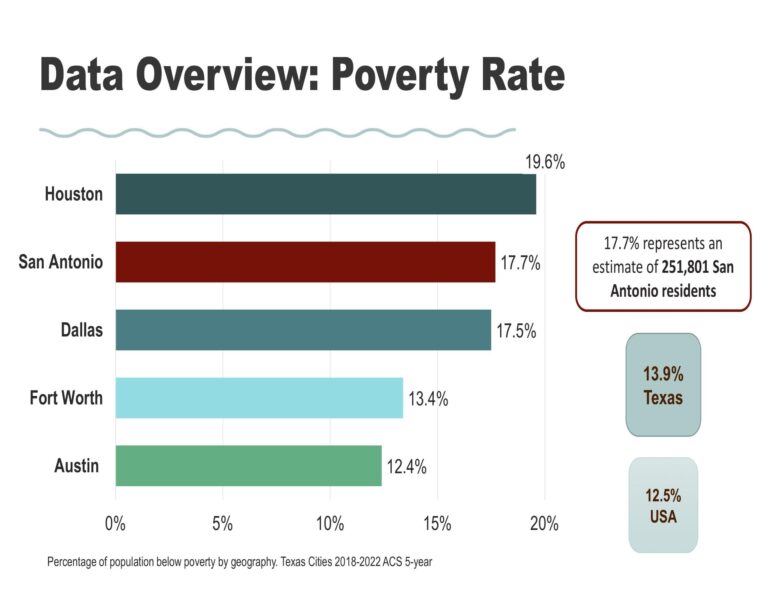San Antonio Emerges as One of the Nation’s Poorest Major Metro Areas
According to the most recent census figures, San Antonio now ranks as the third metropolitan area with the highest poverty rate among large U.S. cities. This alarming statistic highlights ongoing economic hardships that persist despite the city’s steady population growth and urban development. The data calls attention to the critical need for focused policy measures aimed at reducing income disparities and enhancing the quality of life for many residents within the San Antonio metropolitan region.
Factors fueling this poverty surge include:
- Wage stagnation amid rising living costs
- Unequal access to education and workforce training
- Housing expenses increasing faster than household incomes
| Metropolitan Area | Poverty Rate (%) |
|---|---|
| Detroit | 20.1 |
| Cleveland | 19.5 |
| San Antonio | 18.7 |
Root Causes Behind San Antonio’s Economic Difficulties
San Antonio’s poverty predicament stems from a blend of entrenched systemic challenges that have compounded over time. The city’s labor market is dominated by low-paying service jobs, which often lack benefits and job security. Educational inequities further limit residents’ ability to secure higher-paying employment, while healthcare access remains uneven, leaving many without necessary medical support. Moreover, the city’s rapid population increase has intensified competition for affordable housing and employment, deepening economic vulnerability for many families.
Major contributors include:
- Employment Landscape: Predominance of low-wage, service-oriented positions with limited advancement prospects.
- Education System: Underfunded schools and insufficient vocational programs hinder skill development.
- Healthcare Accessibility: A significant portion of residents lack health insurance, restricting preventive care.
- Housing Market: Soaring rent and property prices outpace income growth, increasing housing insecurity.
| Challenge | Effect on Residents |
|---|---|
| Low-Wage Employment | Limits financial stability and upward mobility |
| Educational Gaps | Restricts access to skilled jobs and career growth |
| Healthcare Deficiencies | Increases health risks and emergency care reliance |
| Housing Affordability | Contributes to homelessness and housing instability |
How Poverty Impacts San Antonio’s Neighborhoods and Public Systems
The escalating poverty rate in San Antonio has profound repercussions on community well-being and the capacity of public services. Families grappling with financial insecurity often face obstacles in securing nutritious food, safe housing, and dependable transportation. These hardships not only affect day-to-day living but also limit educational and employment opportunities, perpetuating a cycle of poverty. Neighborhoods with concentrated poverty experience higher crime rates and health disparities, which further strain social cohesion.
Public institutions are increasingly stretched thin as they attempt to respond to the growing needs of impoverished populations. Local agencies and nonprofits face budget constraints while trying to expand their reach. Key areas under pressure include:
- Healthcare: Clinics and hospitals are overwhelmed by chronic illness and emergency cases.
- Education: Schools require additional resources to support students from low-income families.
- Housing Assistance: Shelters and affordable housing programs struggle to meet demand.
- Public Safety: Law enforcement deals with increased calls related to poverty-induced social issues.
| Sector | Challenges | Community Consequences |
|---|---|---|
| Healthcare | Overcrowded emergency rooms and clinics | Longer wait times and diminished care quality |
| Education | Resource shortages for disadvantaged students | Lower graduation rates and achievement disparities |
| Housing | Increasing homelessness and shelter shortages | Unsafe living environments and displacement |
| Public Safety | Rising poverty-related emergency calls | Strained police resources and slower responses |
Approaches to Mitigate Poverty and Encourage Economic Resilience in San Antonio
Addressing San Antonio’s poverty crisis requires a comprehensive strategy that not only alleviates immediate hardships but also promotes long-term economic vitality. City officials and community advocates are prioritizing the expansion of employment opportunities in fast-growing sectors like clean energy and information technology, aiming to provide residents with better-paying, sustainable jobs. Enhancing access to quality education and vocational training remains a cornerstone of these efforts, equipping the workforce with skills relevant to evolving market demands.
Support for entrepreneurship is also gaining momentum, with programs offering mentorship, small business loans, and networking platforms to empower local startups. The following table outlines key focus areas and anticipated impacts over the next five years:
| Focus Area | Core Initiative | Projected Outcome |
|---|---|---|
| Workforce Enhancement | Skills training and certification programs | Increase skilled labor pool by 20% |
| Economic Diversification | Investment in renewable energy and tech startups | Boost GDP by 15% |
| Entrepreneurial Support | Microloans and business incubators | Launch 500+ new businesses annually |
| Affordable Housing Initiatives | Community-led housing development projects | Reduce homelessness by 10% |
Final Thoughts on Tackling Poverty in San Antonio
As San Antonio grapples with one of the highest poverty rates among major U.S. metropolitan areas, the latest census data serves as a stark reminder of the urgent need for comprehensive economic and social reforms. City leaders, policymakers, and community organizations must collaborate to address the underlying causes of poverty and implement sustainable solutions that uplift thousands of residents. Ongoing data analysis and community engagement will be vital in reversing these trends and fostering a more equitable and prosperous future for San Antonio.




